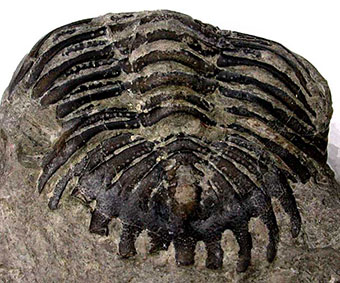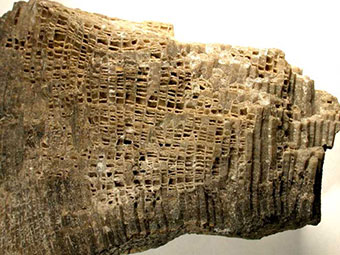A Step Back in Time
by Jack Foran


Consider a fossil-hunting expedition to Penn Dixie this summer
Consider a time-travel trip this summer. You don’t have to go far to go far back. Like about 380 million years back. That’s roughly 200 million years before the major age of dinosaurs.
The land that’s now Western New York—380 million years back—was under tropical ocean, well south of the equator.
That is, was being formed under tropical ocean, by sediment deposits that included all the little plants and animals that inhabited that ocean at that time. Including plentiful trilobites, crinoids (sea lilies), pelecypods (clams), brachiopods (another type of bivalve, that is, with two hinged shells, but with a stalk-like appendage to attach to the sea floor), gastropods (snails), bryozoans (plant-like animals, delicate branched structures), cephalopods (of various forms, some segmented and elongated, some nautilus-like spirals), and corals.
That time period is known as the Devonian, and a prodigiously fossil-bearing outcrop of Middle Devonian-age rock occurs at the Penn Dixie site in Hamburg, consisting of some 50 acres of the remains of an old quarry.
“Actually, the whole lake shore region south of Buffalo is prime fossil territory,” according to Jerry Bastedo, the geologist who started up and oversees the Penn Dixie site, which is owned and operated by the Hamburg Natural History Society, Inc.
“But a significant stratigraphic column—that is, comprising a significant number of stratigraphic layers—is only exposed in locations such as along cliffs along deep-cut watercourses—such as Eighteen-Mile Creek—and the lakeshore. Moreover, most of the best fossil-hunting locations are on private property. You can’t just wander on to look for fossils or anything else.”
Quarrying operations at the Penn Dixie site removed the top 10 feet or so of surface shale—which due to its high calcium carbonate content was useful for cement production—but then were abandoned around the 1960s, just as the most fossil-bearing layers were being exposed. Because of the upward tilt of the stratigraphic layers—due basically to the original depositional environment (in the tropical ocean), along the slope of a continental shelf—significant Middle Devonian stratigraphy is exposed on the surface across the length and breadth of the Penn Dixie site.
Fossil-hunters are provided with a handy illustrated chart for identifying the specimens they find.
Living flora and fauna are also site features, including a seldom seen but several times photographed coyote. And usually killdeer, which make their nests on gravel, and if you get too close to the nest will run or fly a short distance off, and there perform their signature feigned-broken-wing trick to lure you from the nest area. A wonderful thing to see, and a most beautiful bird, with its distinctive necklace black bands.
Bird-watching is another regular activity on the site in cooperation with the Buffalo Ornithological Society and other birder groups.
Another activity is star-gazing. Astronomy evenings are regularly scheduled throughout the summer. Telescopes and trained personnel are available to assist viewing, or of course you may bring your own telescope.
Site entry fees (for non-members) for fossil-hunting are $7 per adult, $6 for children ages three to 12. ”But you keep what fossils you find. And nobody goes away empty-handed,” according to Bastedo, due to the abundance of fossils on-site and the ease of collecting them.
Memberships are welcomed and encouraged. See the site website for details. The official name of the site is the Penn Dixie Paleontological and Outdoor Education Center, but just google on “Penn Dixie.”
Details on all special activities are also on the website, including astronomy evenings and bird walks, and special kid-oriented events such as an upcoming Children’s Day (June 5) and the annual Big Toys, Trucks, and Bikes Event (June 26). Week-long summer day camps for kids are also offered.
The Penn Dixie site is located between Lake Shore Road (Route 5) and South Park Avenue, and Milestrip and Big Tree roads, off Big Tree. More elaborate directions, including from the I-90, are on the website.
blog comments powered by Disqus|
Issue Navigation> Issue Index > v10n22 (Summer Guide, week of Thursday, June 2) > A Step Back in Time This Week's Issue • Artvoice Daily • Artvoice TV • Events Calendar • Classifieds |









 Current Issue
Current Issue